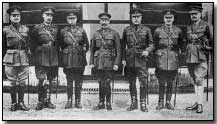Battles - The Battle of Epehy, 1918
 Fought in the wake of successful encounters at
St Mihiel and
Havrincourt, the Battle of Epehy was directed against forward outposts
of the Hindenburg Line, and was chiefly conducted by
General Rawlinson's Fourth Army
on 18 September 1918.
Fought in the wake of successful encounters at
St Mihiel and
Havrincourt, the Battle of Epehy was directed against forward outposts
of the Hindenburg Line, and was chiefly conducted by
General Rawlinson's Fourth Army
on 18 September 1918.
British and French forces - the latter represented by Marie-Eugene Debeney's First Army - had reached strong points of the Hindenburg Line by early September. Rawlinson favoured a prompt attack against established German forward positions but was over-ruled by British Commander-in-Chief Sir Douglas Haig.
Haig was mindful of ongoing heavy British casualties incurred during offensives earlier in the year, preferring instead to pause for a period before recommencing the Allied advance. He changed his mind however after reviewing the rapid successes of the British at Havrincourt and the Americans at St Mihiel, both indicating a weakening of German resolve and strength.
On 13 September Haig therefore authorised an attack by all three corps of Rawlinson's Fourth Army, aided by a corps from Sir Julian Byng's Third Army (who had successfully taken Havrincourt village on 12 September).
The British assault was greatly assisted by a creeping barrage involving some 1,500 guns, with the addition of 300 machine guns. French assistance however, which had been promised in the south, never materialised, and success was limited on its flanks, but the centre of the advance - led by two divisions of the Australian Corps under General Monash - quickly gained around three miles.
Although by no means a large-scale success, Epehy, along with Havrincourt and St Mihiel before it, confirmed present German weakness, and thus encouraged further Allied action sooner rather than later, by which time the Germans may have consolidated their positions.
Photograph courtesy of Photos of the Great War website
A Communication Trench was a narrow trench constructed at an angle to a defensive trench to permit concealed access to the defensive trench.
- Did you know?
